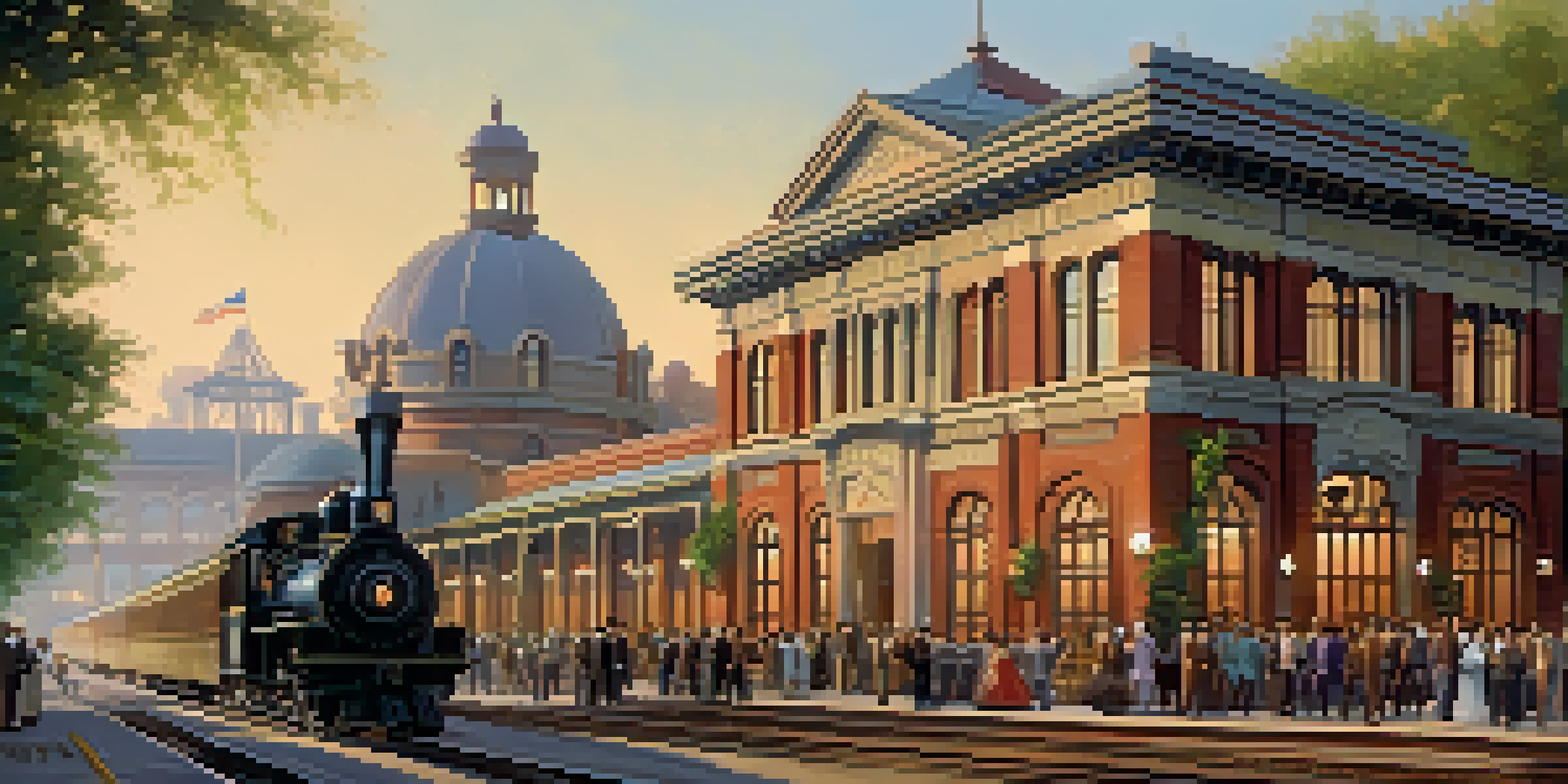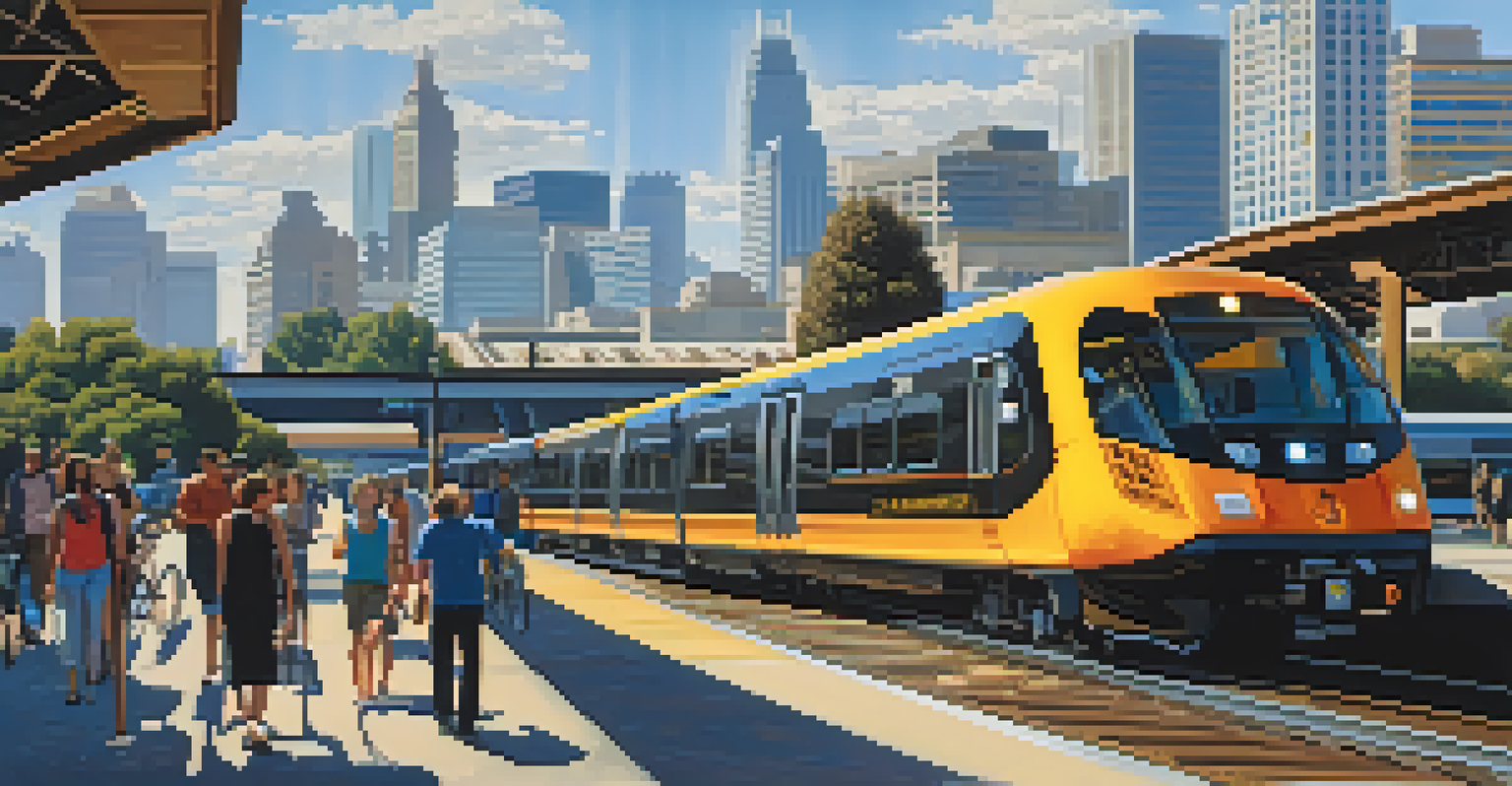The Birth of Sacramento's Railroads: A Historical Overview

The Early Beginnings of Sacramento's Railroads
In the mid-19th century, Sacramento emerged as a bustling hub due to the Gold Rush. The influx of fortune seekers created a demand for efficient transportation, laying the groundwork for the city's railroads. The original plans were ambitious, aiming to connect the city to vital markets and resources.
Railroads are the arteries of our economy, connecting regions and fostering growth.
In 1856, the first railroad line, the Sacramento Valley Railroad, was established, linking Sacramento to the agricultural regions of the Central Valley. This connection was crucial for the transport of goods, facilitating trade and boosting the local economy. It was a game-changer for a city that was rapidly growing and needed infrastructure to support its expansion.
As the city continued to thrive, the introduction of railroads not only helped transport people and goods but also spurred urban development. With each new line, neighborhoods began to form, and Sacramento's identity as a vital transportation hub solidified.
The Impact of the Transcontinental Railroad
The completion of the Transcontinental Railroad in 1869 marked a monumental moment in Sacramento's history. This project linked the East and West coasts, making Sacramento a pivotal point for travelers and freight alike. The city quickly became a vital stop for those journeying across the nation.

With the Transcontinental Railroad, Sacramento's economy experienced a significant boost. Local businesses thrived as they catered to the needs of travelers and freight companies. The railroad not only provided jobs but also opened new markets for local products, particularly agricultural goods.
Sacramento's Railroads Boosted Growth
The establishment of railroads in Sacramento during the 19th century was pivotal in connecting the city to vital markets, spurring economic development and urban expansion.
This connectivity also encouraged migration, as people from various backgrounds flocked to Sacramento for opportunities. The diverse population contributed to a rich cultural tapestry, further enhancing the city's appeal and making it a vibrant place to live.
The Rise of Local Railroads in the 1880s
As the 1880s rolled in, Sacramento saw the emergence of several local railroads, further enhancing its transportation network. These smaller lines connected outlying areas to the central hub, allowing for even greater accessibility. It was a time of innovation, with railroads adapting to the needs of the growing population.
The railroads are a great symbol of the American spirit of exploration and adventure.
One notable line was the Southern Pacific Railroad, which expanded its reach significantly during this period. Its commitment to connecting various regions helped solidify Sacramento's status as a commercial powerhouse. Local industries flourished as products could be transported swiftly and efficiently.
The expansion of local railroads also encouraged the development of new neighborhoods and businesses. As trains brought people to the city, Sacramento transformed, evolving into a thriving urban center that continued to attract newcomers seeking a better life.
Challenges Faced by Sacramento's Railroads
Despite the growth and success of Sacramento's railroads, challenges were inevitable. Natural disasters, such as floods and earthquakes, posed significant threats to the infrastructure. These events often disrupted service and required costly repairs, straining resources.
Additionally, competition between different railroad companies created tensions. Each sought to dominate the market, sometimes leading to conflicts over routes and pricing. This rivalry, while beneficial in driving innovation, also left some companies struggling to survive.
Transcontinental Railroad's Impact
The completion of the Transcontinental Railroad in 1869 transformed Sacramento into a crucial hub for commerce and migration, significantly enhancing its economy and cultural diversity.
Political issues further complicated matters, as regulations and taxes on railroads fluctuated. These challenges prompted many railroad companies to adapt and innovate, ultimately shaping the future of Sacramento's transportation landscape.
The Transition to Modern Transportation
As the 20th century approached, the landscape of transportation began to change dramatically. The rise of automobiles and highways posed a new challenge to the railroads. Many people preferred the convenience of personal vehicles, impacting ridership and freight transport.
In response, Sacramento's railroads had to adapt to the shifting transportation needs of the community. Innovations such as improved freight services and commuter trains were introduced to attract passengers and businesses alike. This transition was essential to remain relevant in an evolving transportation ecosystem.
Despite these challenges, the railroads paved the way for modern transit systems. Today, Sacramento's public transportation network still honors its railroad heritage while embracing new technologies and methods to serve the community better.
Cultural Significance of Sacramento's Railroads
The impact of Sacramento's railroads extends beyond mere transportation; they have significantly influenced the city's culture and identity. Historic train stations, such as the iconic Sacramento Depot, stand as testaments to the city's rich transportation history. These landmarks remind residents and visitors alike of the days when rail travel was the primary means of long-distance transportation.
Railroads also fostered a sense of community, as people gathered at stations to greet travelers and share stories. The connections formed through these interactions enriched the cultural fabric of Sacramento, creating bonds that transcended geographical boundaries. Festivals and events celebrating the railroad heritage continue to be cherished traditions.
Future of Railroads in Sacramento
Sacramento is focusing on modernizing its rail system through sustainability initiatives and integrating different transportation modes to address the needs of a growing population.
Moreover, the railroad's influence is evident in local art, literature, and music, where themes of travel and adventure abound. The legacy of Sacramento's railroads lives on, inspiring new generations to appreciate the city's unique history and the journeys that shaped it.
Looking Ahead: The Future of Railroads in Sacramento
Today, Sacramento is exploring new avenues to reinvigorate its rail system, focusing on sustainability and modern transit solutions. Projects aiming to enhance the existing rail infrastructure are underway, aiming to meet the demands of a growing population. Innovations in electric and high-speed trains are being discussed as part of this vision.
The city is also considering how to integrate railroads with other modes of transportation, such as buses and bicycles. This holistic approach aims to create a seamless transit experience for residents and visitors alike. By connecting various transit options, Sacramento hopes to reduce traffic congestion and promote environmentally friendly travel choices.

As Sacramento looks to the future, the railroads will undoubtedly play a crucial role in shaping the city’s growth and connectivity. By honoring its historical roots while embracing modernization, Sacramento’s railroads will continue to be a vital part of its identity for generations to come.